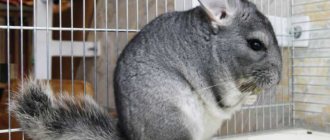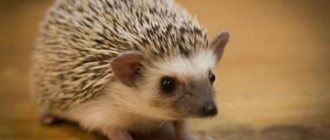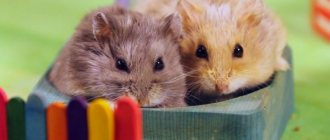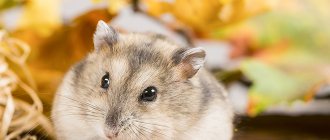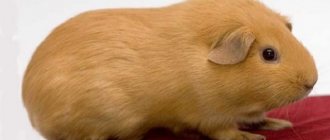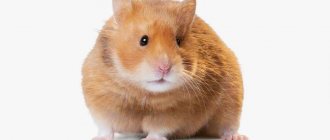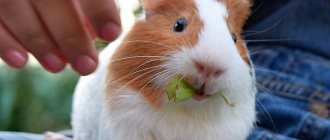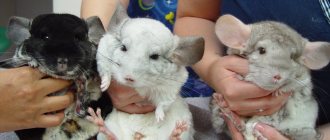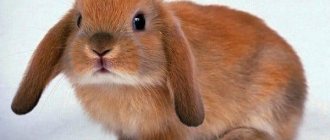Chinchillas are adorable pets, but they are very cautious and shy. A chinchilla lives at home for 6–10 years. Female chinchillas are usually larger than males. Body weight varies from 400 to 600 g.
Long-tailed chinchillas are naturally found in the Andes Mountains in South America. These rodents are known for their long ears and soft, luxurious fur. Chinchillas have the thickest fur of all land animals - more than 20,000 hairs per cm2. In most animals, each hair grows from a separate hair follicle, while in chinchillas there are more than 50 hairs in each. It is not surprising that a real hunt began for their unusual skins.
The history of trade in these skins began in the 15th century and by the end of the 19th century, chinchillas practically disappeared from the wild. Nowadays, chinchillas are increasingly bred as pets.
Where to buy a chinchilla
Interested in rehoming a pet?
Royal Persian Angora
If you are purchasing a young chinchilla, it is best to see the babies with their mother, and ideally with other chinchillas from the same family. Adults should appear healthy and cages should be clean and spacious. The breeder should ask you many questions and offer information on how to care for chinchillas.
There are now some chinchilla rescue organizations that may have unwanted adults or young adults looking for loving homes, and charities such as Blue Cross sometimes bring in chinchillas for rehoming.
Chinchillas are not happy alone, so if possible, it is worth getting two at the same time. Littermates will live happily together, but if they are not the same sex, make sure the male is spayed to prevent them from breeding.
Placing chinchillas
Chinchillas are usually kept indoors, which is best suited to our climate. They can survive in fairly cold temperatures, but drafts can be very dangerous for them, so they should be kept in a draft-free area. They are prone to heat stroke in warm conditions, so never place the cage in a sunny window. Since they are nocturnal, it is probably best not to put them in the bedroom.
Breeding chinchillas
Chinchillas are quite large for a small pet and are very active, so they need a lot of space. The minimum cage size for a couple is approximately 1m x 1.5m, 1.3m high, with shelves of varying heights. Chinchillas should be allowed to exercise under supervision as often as possible and at least once a day. Use bedding or shredded paper at the bottom of the cage.
Chinchillas need an enclosed bed to sleep during the day. It should be large enough for all the animals in the cage to curl up if they want, but there should be enough drawers for each chinchilla in case they want to have their own space. Wooden crates are ideal, but anything you use will eventually get chewed up and need to be replaced.
Farm organization
Premises requirements
- Space. To keep 50 females, you can set aside a room in a residential building or make a small aisle. For a larger population, it is necessary to build a separate brick or wooden building.
- Daylight. It is necessary to have daylighting, which has a beneficial effect on the animals’ metabolism and fertility. In order for all cages to be equally illuminated, they must be installed along the windows; direct rays of the sun should not fall on the animals. Windows should be covered with mosquito nets.
- Artificial lighting. Nocturnal animals will need an additional light source. To do this, you need to use lamps of 5 W/sq.m.
- Temperature. The indicator should be constant and vary from 18 to 20 ⁰С. In winter, heaters will be needed to maintain warmth. For control, mercury and electric thermometers are used.
- Humidity. The optimal humidity level for chinchillas is 55-65%.
- Ventilation. The supply of fresh air and the removal of excess moisture, gases, dust and bacteria is an important point when keeping animals with weak immunity.
- Soundproofing. If the room is located in close proximity to a residential area, then at night rodents will disturb the sleep of all household members. The chinchillas themselves should also be protected from loud, sharp sounds.
Introducing chinchillas
To introduce your new chinchilla to the one you already have, place them in separate cages side by side, about 10cm apart. This way they can smell each other without physical contact. Place the beds at opposite ends of the cages so they feel like they have somewhere to escape. Give each chinchilla its own dust bath, but change it daily so they get used to each other's scent.
Southern viscachas
After about a week, move the cages and beds closer until the chinchillas start sleeping next to each other. It is important to introduce them slowly to avoid fighting. When the two seem to be living happily side by side, place the existing chinchilla in the new chinchilla's cage. They may get used to each other immediately or there may be some initial arguments. If it seems serious, separate them for a few more days, but it will settle down over time. It is usually easier to introduce animals of the opposite sex (you need to castrate the male first) or introduce a young chinchilla to an adult.
Exercises and training for chinchillas
Chinchillas are nocturnal, so they sleep most of the day. They are most active in the early evening, so now is a good time to take them out for a run. Make sure they are supervised because they love to explore everything with their teeth, including electrical wires.
Before you let your chinchillas run around your house, make sure you can catch them again. Chinchillas can be tamed with a little time and training. When the chinchilla comes forward, gently pet it under the chin. Don't try to catch them the first time, just give them a treat and let them go so they don't associate you with being caught. Raisins are one of their favorite treats, so offer them by hand. Be careful because a scared chinchilla will stand on its hind legs and spray urine at any potential threat!
Once your chinchilla is confident in taking treats and allows you to pet him, you can release him outside. Start with a small space and then try offering a treat to encourage your pet to come to your arm. Don't try to catch the chinchilla just yet, but give him a treat and release him again several times.
To pick up your chinchilla, support their entire body with your hand and gently hold them by grasping the base of the tail. Never pick up a chinchilla by the tail as this can hurt it or cause serious injury. A frightened chinchilla that is handled too tightly will shed chunks of fur, so if this happens you will be being too rough.
Color features
Chinchillas are a whole family of domestic rodents, which includes 14 breeds and 12 interbreed mixtures.
They differ mainly in color. Descriptions of chinchillas of typical colors:
- Gray is a natural “wild” color;
- White velvet - white body, dark stripes on paws, dark head;
- White Wilson - the edges of the ears are dark, the fur is white to slightly grayish;
- Beige - the belly is white, the rest of the body and head are beige, and the ears are pinkish;
- Brown velvet - pinkish ears, brown head, white belly with a brownish tint;
- Homobeige - cream fur, pink eyes;
- Black velvet - black body and head, stripes on paws, white belly;
- Purple velvet - the back and head are gray with a lilac tint, there are stripes on the paws;
- Violet – gray fur with a slight purple tint, white belly;
- Purple ebony – uniform dark purple color;
- Sapphire – fur color with a blue tint;
- Blue Diamond – color with lilac-blue tones;
- White-pink – white fur, light pink ears;
- White-pink velvet - white fur, light brown stripes on the paws, pink ears, dark head;
- Charcoal – dark with a brown tint, gray belly;
- White Ebony is a white chinchilla, but there are dark spots on the body and head, the ears are almost black;
- White-pink ebony – white color, pinkish ears;
- Chocolate – light or dark brown, beige ears;
- Pastel – colored brown, belly slightly lighter;
- Velvet pastel - brown color, stripes on the paws, cream or pinkish ears;
- Homobeige pastel – chocolate brown, uniform color;
- Velvet ebony - the color of the animal is dark, almost black, but the sides are slightly lighter;
- Homoebony - color completely black, coat with shine;
- Heteroebony – uneven dark color.
How to clean a chinchilla?
In the wild, chinchillas use fine sand to keep their coats clean and in great condition, and you need to do this in the form of a dust bath. Chinchilla dust can be purchased at most pet stores. Never use regular sandbox or building sand as it is too coarse and can damage your chinchilla's fur and skin.
The bath should be large and deep enough for the chinchilla to roll around in without getting hurt, so the dust should be about 10cm deep. Chinchillas should be offered baths once a day for about 20 minutes. If you leave the bath for longer, it may become dirty and your chinchilla will not want to use it. Change the dust at least once a week. Also check their eyes because dust accumulation can cause eye problems.
What do chinchillas eat?
Chinchillas are herbivores, and in their native South America they eat grasses, low-growing green plants and chew bark from trees. Chinchillas need a diet high in fiber and protein, but low in moisture and fat. Foods high in fat can cause liver disease, while greens that are too lush can cause colic or lead to bloating. Lack of fiber in the diet leads to impaired bowel movements, tooth overgrowth and even fur chewing. They also need a diet high in vitamin C, so they should not be fed rabbit formula.
Chinchilla on the scales
Chinchilla food can be purchased at pet stores. The kibble type is best because in formulas, your chinchilla can pick out favorite bits, resulting in an unbalanced diet. The pellets you feed your chinchilla should amount to about one tablespoon per day for a healthy adult.
However, pellets themselves are not enough - chinchillas also require a constant supply of good quality hay. Place hay in a small grid and fill it every day. As with all animals, make sure they have a constant supply of fresh drinking water.
Diseases
The animals have fairly good health, and the appearance of illnesses is mainly possible due to improper care and maintenance of chinchillas: insufficient cleaning of the cage, poor nutrition.
How long chinchillas live depends on disease prevention and timely treatment. At the first sign of discomfort, you should take your pet to the veterinarian. What you should be wary of:
- loss of appetite;
- hair loss;
- weight loss;
- change in tooth or skin color;
- hard belly;
- the appearance of bad breath.
Diseases of the gastrointestinal tract are easily diagnosed and treated mainly with diet. With constipation, not only the feces change, but also the behavior: the animal sits in the corner of the cage and rocks. For treatment, they give laxative food, vaseline oil and a laxative. Indigestion with diarrhea is treated with activated charcoal and dietary restrictions. When bloated, the chinchilla loses activity and the temperature drops. They also treat with charcoal.
Dental diseases are obvious by their discoloration and excessive secretion of saliva. Vitamin deficiencies are compensated for by nutrition. A malocclusion is treated by a doctor.
Chinchillas may have a cold. When it occurs, the temperature rises and a runny nose appears. For treatment you need to get rid of drafts and feed well. Medicines are prescribed only by a veterinarian.
A common eye disease is conjunctivitis. It is treated with medication and herbal compresses.
A chinchilla can become infected with fungal diseases and lichen. The disease begins with peeling of the skin and the appearance of bald spots. If these signs occur, you should stop bathing to avoid spreading the disease and immediately contact a veterinarian.
Chinchilla treats
Raisins and sultans are ideal treats for chinchillas and can also be used as training rewards. Don't feed your chinchilla too much so that they still perceive raisins as a treat.
Some chinchillas also like a small piece of fresh vegetables, such as carrots, but try not to give them too much because it can cause diarrhea. Peanuts and sunflower seeds should be avoided as they are too fatty.
Don't give them too many treats as this can upset their stomach.
What to feed?
A properly formulated diet for a pet is the key to its health. The basis of chinchilla nutrition is special ready-made dry food, which should be purchased at pet stores. The purchased diet is ideally balanced for feeding a pet and is divided into types, depending on the age of the rodent. It contains all the necessary minerals and trace elements for growth and normal development.
It is necessary to put food in the feeder every evening before bed, when the pet's activity phase begins. The following additional components should be present in the chinchilla's diet as a treat:
- green plants: clover, yarrow, alfalfa, nettle, dandelion, apple and hazel branches;
- fruits and berries: rose hips, figs, raisins, dried apricots, beets, dried carrots, dried apples;
- hay of legumes, cereals, multi-colored and asteraceous crops.
Delicious berries
Some foods are contraindicated for chinchillas, for example, cabbage and raw potatoes. The rodent's stomach will not be able to digest meat products, cheeses and milk. You should not spoil your pet with food from the table, since such a treat will give him severe stomach pain in the future.
The following herbs are poisonous to rodents:
- horsetail;
- fern;
- buttercup;
- henbane;
- St. John's wort.
Chinchilla dental care
Like all rodents, chinchillas' teeth are constantly growing, so they need a lot of hard material to eat and chew. A piece of apple tree or a pet store toy for your pet to chew on can help prevent dental problems.
Unfortunately, even the best-kept chinchilla can develop dental problems, and these can become serious if left untreated. Signs to look out for include reluctance to eat, drooling, wetness under the chin, and runny nose. If your chinchilla is exhibiting any of these symptoms, it is important to have your veterinarian check his teeth.
Negative…
- Chinchilla loves to chew everything in its path. Therefore, free movement around the house will result in chewed furniture and wires.
- The animal's house occupies a fairly large space.
- If you forget to keep your chinchilla's house closed, it can run away, and finding your pet will become problem No. 1.
- Quite a lot of dirt and dust from the contents. For example, the formation of dust in the house every time after swimming in the sand.
- The animal does not tolerate drafts, temperature fluctuations, or high indoor humidity.
- The rodent is active at night, which contributes to sleep disturbance due to the noise made by the animal.
- Since this is an exotic animal, if there are any diseases, it is difficult to find a veterinarian who specializes in such species.
